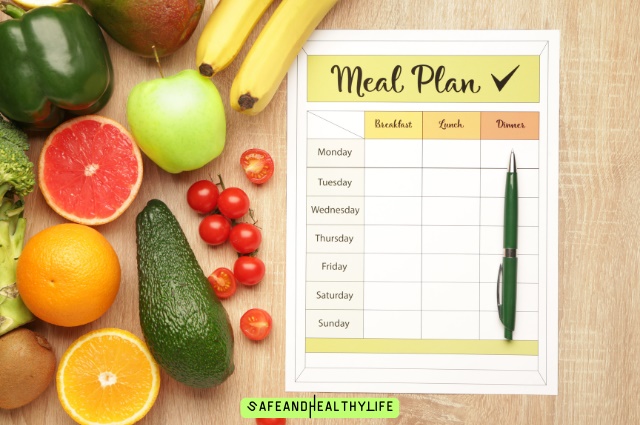
You may also like:
- How to Naturally Cleanse and Detox Your Body
- Getting into Fitness as a Beginner
- 9 Cooking Myths That Many People Believe Are True
In a world where staying healthy can sometimes feel expensive, it’s comforting to know that getting healthier doesn’t have to cost a fortune.
You can take care of your health without emptying your wallet. With some clever thinking, careful planning, and a commitment to positive changes, you can start a journey to better health while staying within your budget.
This article will guide you through 10 practical steps to create a healthier lifestyle without overspending.
1. Choose Nutritious Foods Without Breaking the Bank
Improving your diet doesn’t have to strain your wallet. Prioritize foods that provide your body with essential nutrients like vitamins and minerals.
Staples such as whole grains, beans, eggs, frozen fruits, and vegetables are rich in goodness and won’t burn a hole in your pocket.
Organize your meals around these wallet-friendly options to ensure a well-rounded and wholesome diet that promotes both health and savings.
2. Cook at Home
Opting for home-cooked meals can be a wallet-friendly choice compared to dining out. The advantage lies in the ability to control ingredients and costs.
Experiment with simple recipes that rely on affordable ingredients. Preparing larger portions than needed and freezing leftovers reduces waste and saves time and money.
This way, you’ll always have a delicious meal without worrying about expenses or compromising your health.
3. Choose Fresh, Seasonal Foods
Embracing fruits and vegetables in their prime season enhances their taste and eases the burden on your wallet.
Seasonal produce tends to be more abundant and reasonably priced during specific times of the year.
Seek out local markets or consider participating in programs supporting local farmers to access fresh, budget-friendly produce.
This approach not only promotes health but also supports the community.
4. Plan Your Meals

Mapping out your weekly meals can guide you toward wiser choices and reduce food wastage.
Before grocery shopping, outline your meals and snacks while considering the available items at home. You could even opt to order affordable meal prep for your home to make it even easier.
Sticking to your plan minimizes unnecessary purchases and helps maintain a balanced budget.
By following this approach, you’re making healthy choices and economizing effectively.
5. Skip Unhealthy Snacks
While junk food may offer convenience, it often comes at the cost of health and finances. These snacks can lead to health issues and accumulate expenses over time.
Instead of opting for pre-packaged treats, create your own using options like nuts, yogurt, or freshly chopped fruits and vegetables.
Not only do these choices promote better well-being, but they also prove economical in the long run.
6. Embrace Cost-Free Physical Activity
Prioritizing an active lifestyle needn’t come with a financial burden. Engaging in activities such as walking, jogging, hiking, or cycling outdoors comes at no cost.
Numerous locations provide opportunities for free or budget-friendly exercise classes, and a wealth of online resources offer workout routines that demand no specialized equipment or investment.
7. Indoor Workouts on a Budget

For those who prefer indoor exercise, an extravagant gym membership is not necessary. Explore the realm of workout videos or user-friendly apps that guide you through practical home-based exercises.
Affordable items like resistance bands or weights can augment your fitness regimen without breaking the bank, enabling you to maintain your fitness journey comfortably within your living space.
8. Nurture Your Mental Wellness
Remember, caring for your mental health is integral to your overall well-being.
Incorporating mindfulness practices such as meditation and deep breathing into your routine comes at no financial cost yet yields immense stress reduction benefits.
Engaging in activities that bring you joy, spending time in nature’s embrace, and cultivating positive relationships all synergistically contribute to emotional and mental equilibrium.
9. Craft Your Own Goods
Uncover the financial advantages of crafting personal care products within the confines of your home. Ordinary ingredients like coconut oil, oatmeal, and honey possess versatile applications in skincare routines.
Meanwhile, items as simple as baking soda and vinegar can efficiently cleanse your living space.
Not only does this DIY approach save you money, but it also diminishes exposure to potentially harmful chemicals, aligning with a holistic approach to wellness.
10. Prioritize Your Health
Preventing health problems is better than dealing with them later.
Regular exercise, a balanced diet, and managing stress contribute to overall well-being and can lower the chances of chronic illnesses.
Make use of free or low-cost health check-ups and screenings available in your community to stay on top of your health.
Conclusion
Becoming healthier doesn’t have to mean spending a lot. You can improve your well-being without straining your finances by making thoughtful choices and small changes.
Even little steps can lead to big improvements over time. Embrace a positive attitude, be willing to try new things, and feel proud that you’re investing in a healthier future without spending too much.
About The Author:
Stacey Smith is a freelance health writer. She is passionate to write about women’s health, dental health, diabetes, endocrinology, and nutrition and provides in-depth features on the latest in health news for medical clinics and health magazines.




